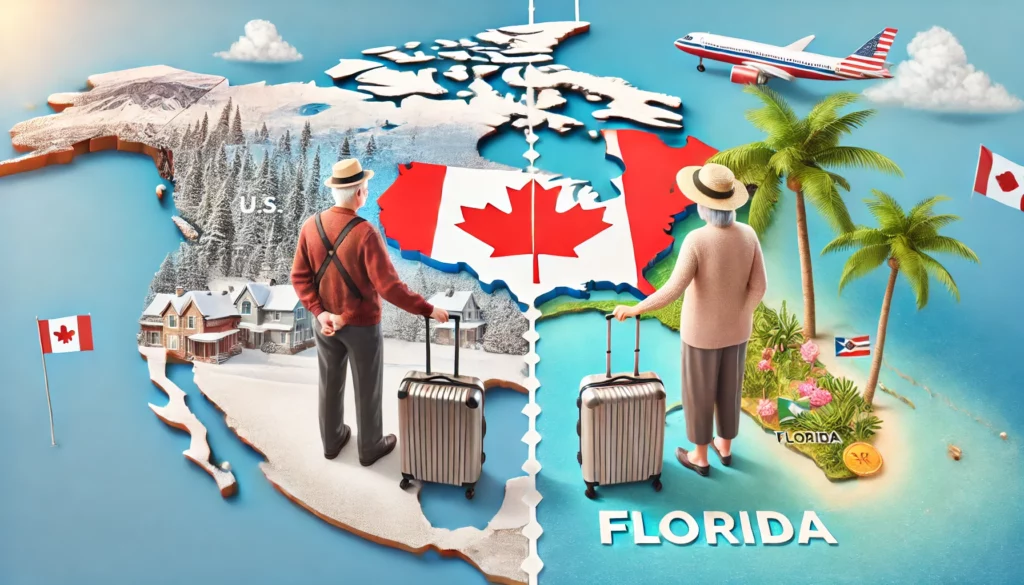Retiring as a snowbird offers Canadian retirees the chance to enjoy warm winters in the U.S. while maintaining ties to home. However, moving part-time between two countries requires careful planning to ensure a smooth transition. In this blog, we’ll cover the most important steps—from securing the right visa to managing finances and finding the perfect home.
Here’s your ultimate checklist for retiring as a snowbird in the U.S. and making the most of your winters down south!
1. Secure the Right Visa
If you’re planning to spend the winter months in the U.S., securing the right visa is essential. Most snowbirds opt to spend less than 182 days in the U.S. each year, which generally doesn’t require a visa. However, for longer stays, you’ll need to consider your options.
- B-2 Tourist Visa: Allows Canadians to stay in the U.S. for up to six months. Perfect for those who want flexibility but require more time.
- Substantial Presence Test: If you spend over 183 days in the U.S. over three years, you might be considered a U.S. resident for tax purposes. Be mindful of the time you spend each year.
To learn more about visa options, visit our detailed guide on Visa Options for Canadians Moving to the U.S.
2. Health Insurance Considerations
Unlike Canada, the U.S. doesn’t have universal healthcare, making it crucial to arrange health coverage during your stay. Consider your health insurance options carefully:
- Travel Insurance: Ideal for shorter stays, providing coverage for medical emergencies while you’re in the U.S.
- Cross-Border Health Plans: If you’re staying for an extended period, look into cross-border insurance that covers both Canadian and U.S. healthcare needs.
- Medicare: If you qualify for U.S. Medicare (available to those 65 and older), consider a supplemental plan to cover any gaps in coverage. Note: Canadian healthcare coverage does not extend to the U.S.
3. Financial and Tax Planning
Managing your finances across two countries requires some careful preparation. Here are key things to consider:
- U.S. Bank Account: Open a U.S. bank account to avoid foreign transaction fees and access funds easily.
- Currency Exchange: Use a service that offers competitive exchange rates when transferring funds from Canada to the U.S.
- Tax Planning: Be aware of your tax obligations. The Substantial Presence Test may trigger U.S. tax filing requirements. Consult a tax professional to understand how U.S. and Canadian tax laws intersect.
4. Finding the Perfect Snowbird Home
One of the most exciting steps in becoming a snowbird is finding your winter home. Whether you’re renting or buying, here are a few tips:
- Rent vs. Buy: Renting may be a better option for first-time snowbirds, giving you flexibility. If you plan to return to the same location each year, buying might be more cost-effective.
- 55+ Communities: Many snowbirds opt for 55+ communities, which offer resort-style living, social activities, and security.
- Condo Management: If you’re purchasing a condo, hire a reliable management company to maintain your property while you’re away. Learn more about condo management here.
5. Prepare Your Canadian Home for Your Absence
Before heading south for the winter, it’s important to prepare your Canadian home for an extended vacancy:
- Winterize Your Home: Ensure your pipes are insulated, and windows are sealed. Set your heating to a low, energy-saving temperature.
- Home Security: Install a security system or hire a home watch service to check on your home while you’re away.
- Mail Forwarding: Set up mail forwarding or arrange for someone to collect your mail during your absence.
6. Arranging Travel Plans
Whether you prefer to fly or drive, planning your travel arrangements early can make your snowbird lifestyle hassle-free.
- Flying: Choose a U.S. destination with convenient access to airports and look for long-term parking options at your departure airport in Canada.
- Driving: If you prefer the flexibility of driving, make sure your vehicle is serviced and road-trip ready. Double-check your insurance coverage for both countries.
7. Traveling with Pets
Bringing your pet along for the snowbird lifestyle? Make sure you follow all necessary procedures to ensure a smooth journey for your furry friend.
- Health Certificates and Vaccinations: Ensure your pet’s vaccinations are current and that you have the required health certificates for travel.
- Air Travel or Road Trip: Depending on how you’re traveling, prepare your pet for a long flight or road trip. Check airline policies for pet travel in advance.
For more details, read our full guide on Bringing Your Pets from Canada to Florida.
Retiring as a snowbird is an incredible way to enjoy the best of both worlds—spending your winters in the warm sunshine of the U.S. while keeping your roots in Canada. By following this checklist, you can make the most of your snowbird experience and ensure a smooth transition into this exciting new chapter.

